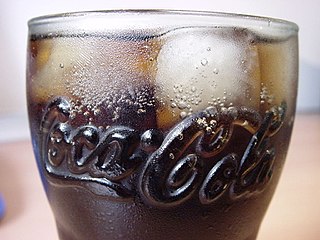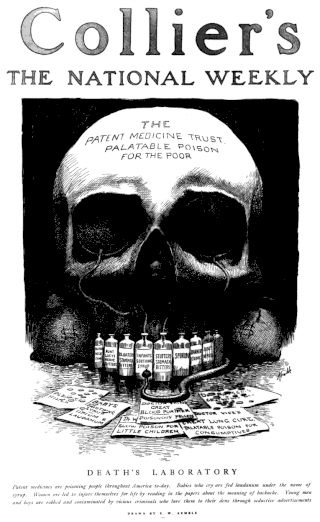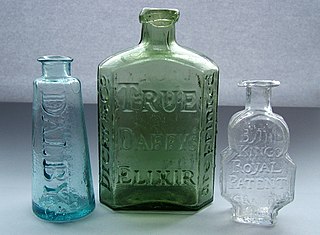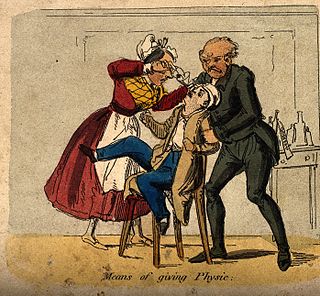
Laudanum is a tincture of opium containing approximately 10% powdered opium by weight. Laudanum is prepared by dissolving extracts from the opium poppy in alcohol (ethanol).

John Stith Pemberton was an American pharmacist and Confederate States Army veteran who is best known as the inventor of Coca-Cola. In May 1886, he developed an early version of a beverage that would later become Coca-Cola, but sold his rights to the drink shortly before his death.

Paregoric, or camphorated tincture of opium, also known as tinctura opii camphorata, is a traditional patent medicine known for its antidiarrheal, antitussive, and analgesic properties.

The Coca-Cola Company's formula for Coca-Cola syrup, which bottlers combine with carbonated water to create the company's flagship cola soft drink, is a closely guarded trade secret. Company founder Asa Candler initiated the veil of secrecy that surrounds the formula in 1891 as a publicity, marketing, and intellectual property protection strategy. While several recipes, each purporting to be the authentic formula, have been published, the company maintains that the actual formula remains a secret, known only to a very few select employees.

A patent medicine, sometimes called a proprietary medicine, is an over-the-counter (nonprescription) medicine or medicinal preparation that is typically protected and advertised by a trademark and trade name and claimed to be effective against minor disorders and symptoms. Its contents are typically incompletely disclosed. Antiseptics, analgesics, some sedatives, laxatives, and antacids, cold and cough medicines, and various skin preparations are included in the group. The safety and effectiveness of patent medicines and their sale is controlled and regulated by the Food and Drug Administration in the United States and corresponding authorities in other countries.

Treacle is any uncrystallised syrup made during the refining of sugar. The most common forms of treacle are golden syrup, a pale variety, and a darker variety known as black treacle, similar to molasses. Black treacle has a distinctively strong, slightly bitter flavour, and a richer colour than golden syrup. Golden syrup treacle is a common sweetener and condiment in British cuisine, found in such dishes as treacle tart and treacle sponge pudding.
The dram is a unit of mass in the avoirdupois system, and both a unit of mass and a unit of volume in the apothecaries' system. It was originally both a coin and a weight in ancient Greece. The unit of volume is more correctly called a fluid dram, fluid drachm, fluidram or fluidrachm.

Chlorodyne was one of the best known patent medicines sold in the British Isles. It was invented in the 19th century by a Dr. John Collis Browne, a doctor in the British Indian Army; its original purpose was in the treatment of cholera. Browne sold his formula to the pharmacist John Thistlewood Davenport, who advertised it widely, as a treatment for cholera, diarrhea, insomnia, neuralgia, migraines, etc. As its principal ingredients were a mixture of laudanum, tincture of cannabis, and chloroform, it readily lived up to its claims of relieving pain, as a sedative, and for the treatment of diarrhea.

The apothecaries' system, or apothecaries' weights and measures, is a historical system of mass and volume units that were used by physicians and apothecaries for medical prescriptions and also sometimes by scientists. The English version of the system is closely related to the English troy system of weights, the pound and grain being exactly the same in both. It divides a pound into 12 ounces, an ounce into 8 drachms, and a drachm into 3 scruples of 20 grains each. This exact form of the system was used in the United Kingdom; in some of its former colonies, it survived well into the 20th century. The apothecaries' system of measures is a similar system of volume units based on the fluid ounce. For a long time, medical recipes were written in Latin, often using special symbols to denote weights and measures.

Baby colic, also known as infantile colic, is defined as episodes of crying for more than three hours a day, for more than three days a week, for three weeks in an otherwise healthy child. Often crying occurs in the evening. It typically does not result in long-term problems. The crying can result in frustration of the parents, depression following delivery, excess visits to the doctor, and child abuse.

Riga Black Balsam is a traditional Latvian balsam often considered to be the national drink of Latvia. According to tradition, only the Head Liquor Master and two of his apprentices know the exact recipe. Nowadays, Riga Black Balsam is produced by JSC Latvijas Balzams and has received more than 100 awards at different international fairs throughout its history.
Domaine de Canton is a ginger-flavored liqueur made in France since 2007. Its earlier formulation was made in China from 1992–1997.

Daffy's Elixir is a name that has been used by several patent medicines over the years. It was originally designed for diseases of the stomach, but was later marketed as a universal cure. It remained a popular remedy in Britain and later the United States of America throughout the eighteenth and nineteenth centuries.
Black draught was a patent medicine used as a purgative in the 19th century and well into the early part of the 20th century, with veterinarians prescribing these to constipated cattle and horses. It is a saline aperient mixture used along with blue mass.

A cordial is any invigorating and stimulating preparation that is intended for a medicinal purpose. The term derives from an obsolete usage. Various concoctions were formerly created that were believed to be beneficial to one's health, especially for the heart.
Warburg's tincture was a pharmaceutical drug, now obsolete. It was invented in 1834 by Dr. Carl Warburg.
Opium and Romanticism are well-connected subjects, as readers of Romantic poetry often come into contact with literary criticisms about the influence of opium on its works. The idea that opium has had a direct effect on works of romantic poetry is still under debate; however, the literary criticism that has emerged throughout the years suggests very compelling ideas about opium and its impact on Romantic texts. Usually these criticisms tend to focus on poets such as Samuel Taylor Coleridge, Thomas De Quincey and George Crabbe.

Godfrey's Cordial was a patent medicine, containing laudanum in a sweet syrup, which was commonly used as a sedative to quiet infants and children in Victorian England. Used mostly by mothers working in agricultural groups or industry, it ensured that she could work the maximum hours of her employment, without being disturbed by her infant, and thus increased the family income. It was also used by nurses and baby-minders to enable them to neglect their duties if they wished.

Confections of the English Renaissance span a wide range of products. All were heavily based on sugar, which was a relatively new development. Many were considered to have medicinal properties – a belief that was influenced by the Arabic use of sugar as a medicine and that carried over from medieval sugar usage. In the mid-sixteenth century, sugar became cheaper and more widely available to the general populace due to European colonization of the New World. It began to be used more as a flavouring, preservative, and sweetener, as it is today, rather than as medicine.













